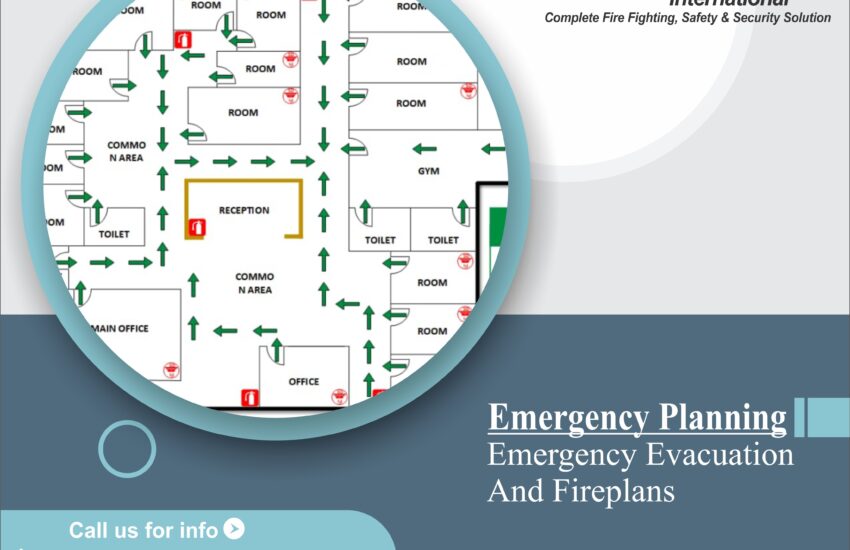Emergency Evacuation And Fireplans Emergencies such as fires, chemical spills, or natural disasters can happen without warning. The best way to protect lives and reduce potential damage is through a well-developed emergency evacuation and fire plan. Whether you manage a small office, a large industrial facility, or a public building, having a clear and actionable plan in place is essential for ensuring the safety of everyone on-site.
This guide will walk you through what emergency evacuation and fire plans are, why they are important, and how to develop one that fits your workplace.
What Is an Emergency Evacuation and Fire Plan?
An emergency evacuation and fire plan is a written document that outlines procedures for evacuating a building during emergencies such as a fire. It provides clear instructions to employees, visitors, and contractors on what to do, where to go, and who to follow in the event of an incident.
These plans help to:
- Protect human life
- Prevent injuries
- Limit property damage
- Reduce business disruptions
- Ensure compliance with safety laws and regulations
Why Every Workplace Needs a Plan
Every workplace has its own unique risks. A plan tailored to those risks can significantly improve safety. Having an emergency plan means your team will know:
- How to respond in an emergency
- Where the exits and assembly points are
- Who is in charge during evacuations
- How to assist others, including people with disabilities
Without a clear plan, confusion and panic can lead to delays, injuries, or worse.
Key Components of an Emergency Evacuation and Fire Plan
1. Risk Assessment Emergency Evacuation And Fireplans
The first step in developing your plan is to identify potential hazards in the workplace. These could include:
- Fire-prone areas like kitchens or electrical rooms
- Hazardous materials
- Overcrowded spaces or limited exits
- Individuals requiring assistance during evacuation
A risk assessment helps you understand the type of emergencies you need to plan for and prioritize safety measures accordingly.
2. Evacuation Routes and Exit Maps
Once risks are identified, create clear evacuation routes throughout the facility. Exit maps should:
- Show all available exits
- Indicate primary and secondary escape routes
- Be posted in visible locations throughout the building
- Be easy to understand for everyone, including non-English speakers and visitors
Keep all exits clear and ensure lighting and signage are functional at all times.
3. Alarm and Alert Systems
Every workplace should have an efficient way to alert people when there’s an emergency. Your plan should include:
- How the alarm is triggered
- Who is responsible for raising the alarm
- Backup communication methods in case systems fail
Regular checks of alarm systems are necessary to ensure reliability during an actual emergency.
4. Roles and Responsibilities
Assign specific roles to team members to ensure a smooth evacuation. Roles may include:
- Fire wardens to guide people and check rooms
- Team leaders to take attendance at assembly points
- Personnel to assist individuals with mobility issues
- Individuals designated to call emergency services
Everyone in the building should know who to follow and what their responsibilities are.
5. Assembly Points and Roll Calls
After evacuation, everyone should proceed to a designated assembly point that is:
- At a safe distance from the building
- Easily accessible
- Large enough to accommodate all staff and visitors
Appoint someone in each team or department to take a roll call to confirm that everyone has exited safely.
6. Training and Fire Drills
A written plan is only effective if everyone understands it. Train staff regularly so they:
- Know how to evacuate safely
- Are aware of escape routes and exits
- Understand who to report to during an emergency
Practice fire drills at least twice a year and after any major changes to staffing, layout, or equipment. Review the results of each drill and update your plan as needed.
Legal and Regulatory Compliance
Many governments and regulatory bodies require businesses to have emergency evacuation and fire plans. These regulations may vary by region, but typically include:
- Clear evacuation procedures
- Regular drills and training
- Proper signage and safety equipment
- Specific accommodations for vulnerable individuals
Staying compliant not only keeps people safe but also protects your business from fines and legal consequences.
Special Considerations
When designing your plan, consider:
- How to assist individuals with disabilities
- How to evacuate from upper floors without using elevators
- Weather conditions that could affect assembly points
- Ensuring temporary workers or visitors understand the procedures
Plans should be inclusive and adaptable to ensure everyone’s safety.
Keeping Your Plan Up to Date
A safety plan isn’t a one-time project. Keep it effective by:
- Reviewing it annually
- Updating it after renovations or organizational changes
- Including new team members in training
- Evaluating your response after real emergencies or drills
Regular updates ensure that your emergency plan continues to reflect the current environment and risks.
Additional Resources Emergency Evacuation And Fireplans
- National and local fire safety regulations
- Fire evacuation map templates
- Workplace safety and emergency planning checklists
- Fire drill logbooks and tracking tools
Conclusion
Emergency Evacuation And Fireplans A well-prepared emergency evacuation and fire plan is a crucial part of any safety management system. It can save lives, reduce injuries, and help your business recover more quickly from unexpected events.


